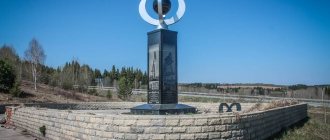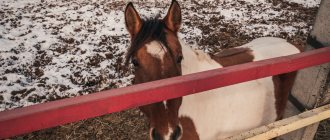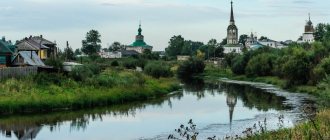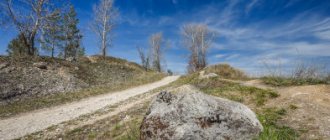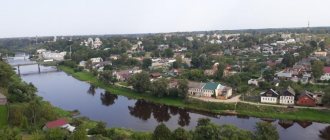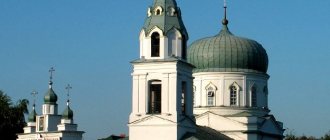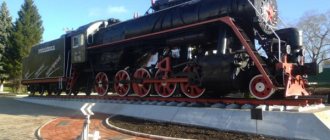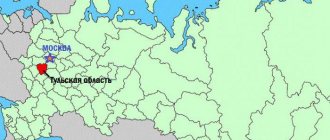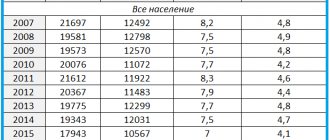Perm is a city in the Urals, the administrative center of the Perm region. It stands on the banks of the large Kama River, below the mouth of the Chusovaya River. Perm stretches along the Kama River for as much as 65 km and in terms of area (800 sq. km) it is the fourth city in Russia (after Moscow, St. Petersburg and Volgograd). Population – 1.05 million people. From 2004 to 2012, the population fell below 1 million inhabitants.
The name of the city is pronounced with a soft “r”. This is contrary to the rules of the Russian language, but this is how it happened historically. Thanks to this feature, local residents can easily distinguish visitors who are not aware of this feature. The word "Perm" was first mentioned in the Tale of Bygone Years in 1113. It is believed that it came from the Finnish-Karelian words “perya maa” - back (distant) land. Until the 18th century, the toponym was used to designate certain territories (Perm the Great, Perm Vychegda), where the Komi people lived.
Perm is a pleasant city with friendly people and a developed culture. In the recent past, they wanted to turn Perm into the cultural capital of Europe. After the change of power, the initiative was curtailed (what a pity!). Nevertheless, Perm remains the city in the Urals with the richest cultural life; many interesting festivals are held here.
History of Perm
Like Yekaterinburg, Perm was founded in 1723 as the Yegoshikha copper smelter. The enterprise was built on the Yegoshikha River near its mouth. The place was chosen by V.N. Tatishchev, and the construction was led by Wilhelm de Gennin. The settlement itself (the village of Yegoshikha) arose here before 1647.
Perm received its modern name and city status by decree of Catherine II in 1780; it became the center of the created Perm governorship. The grand opening of the city and governorship took place on October 18, 1781.
In 1796, by decree of Paul I, the city became the center of the Perm province. K.F. was appointed the first governor. Moderaha. Yekaterinburg at that time was an ordinary county town, but the mining authorities were located in it.
Perm had an advantageous position on a navigable river. The Kama connected the Urals with Central Russia. In 1878, the first railway in the Urals was built, connecting Perm and Yekaterinburg. In 1916, the first university in the Urals was opened in Perm. At the beginning of the 20th century, the population of the city together with Motovilikha was about 100 thousand people.
Old railway station Perm I
On December 13, 1905, a major armed uprising took place in Motovilikha, and clashes between workers and the authorities occurred. After the revolution, in 1918, Prince Mikhail Romanov, the successor to the throne after the abdication of Nicholas II, was brought to Perm. On the night of June 12-13, Mikhail and his secretary were taken out of the city and killed; their bodies have not yet been found.
During the Civil War, clashes took place in the Perm region. The capture of Perm by the Whites and their advance to the west was called the “Perm catastrophe.” In the summer of 1919, the Reds began to recapture these territories. Before retreating, the Whites burned almost all water transport on the Kama, and also blew up the railway bridge across the river.
In 1927, the workers' village of Motovilikha was annexed to Perm. In 1931, Motovilikha received the status of an independent city of Molotovo, and in 1938 it was again included in Perm as the Molotovsky district. In 1940, Perm was renamed Molotov - in honor of the Soviet statesman V.M. Molotov (1890–1986). It was a gift to Molotov for his 50th birthday. In 1941, the workers' village of Zakamsk was annexed to Molotov. In 1957, the city returned its historical name Perm.
Administration building of the Perm region
After the start of the Great Patriotic War, 64 enterprises were evacuated to Molotov, and industry actively developed. In the 1950s, the Kama hydroelectric power station was built in Perm. In 1958, the first stage of the oil refinery was put into operation and the construction of the Communal Bridge was completed, connecting the city center with the right bank part.
Perm became the prototype of the city of Yuryatin in the famous novel by Boris Pasternak “Doctor Zhivago”. It is also believed that the prototype of the city from “Three Sisters” by A.P. Chekhov's city also became Perm, and the prototypes of the heroines were the Zimmerman sisters. By the way, in Perm there is a monument to Chekhov, but it is located far from the center - in front of the Palace of Culture. Chekhov on Gaiva (Repina St., 20).
Among the most high-profile tragic incidents of recent years in Perm: the crash of a passenger plane on September 14, 2008 (88 dead) and the fire in the Lame Horse nightclub on December 5, 2009 (156 dead and 78 injured).
Square near the Perm II railway station
Gallery 3
Lecture at theological school. Source: pastvu.com
Inside the religious school. Source: pastvu.com Men's gymnasium. Source: pastvu.com
Bedroom in a religious school. Source: pastvu.com Sibirskaya street. Source: pastvu.com
Kama embankment. Source: pastvu.com
Unloading watermelons on the embankment. Source: pastvu.com
Black market, chapel of the Holy Prophet Elijah. Source: pastvu.com
Church in the name of All Saints. Source: pastvu.com House of Eremeev (Kamchatov). Source: pastvu.com
Nikolai Slavyanov and workers at cannon factories. Source: pastvu.com Pryanishnikov House. Source: pastvu.com
Perm today
Perm is one of the largest transport hubs in Russia. The city occupies an advantageous geographical position, as it is located in the center of the country at the intersection of the Trans-Siberian Railway with a waterway that provides access to the five seas. Tourist ships operate from Perm, which can take you to Kazan, Moscow, St. Petersburg, and Rostov-on-Don. Small pleasure boats also operate. There is also an international airport in Perm called Bolshoye Savino.
In terms of industrial production, the city of Perm ranks first in the Urals. Among the largest enterprises in the city: oil and gas refining, engine-building complex, shipbuilding, chemical and petrochemical industry enterprises, etc. The head office of the oil company LUKOIL-Perm is located here.
Here they produce: artillery systems, aircraft engines and gas pumping installations, oilfield and mining equipment, electric and gas-powered saws, communication equipment, road construction equipment, river vessels, power tools, Forward bicycles, etc. There is a large printing production - the Perm Printing Factory of Goznak, which produces money and state-issued documents.
Monument "MiG on takeoff"
The left bank part of the city stands on a high bank, dissected by ravines. Perm is famous for its abundance of small rivers (it holds the record for this indicator among Russian cities), however, they are heavily polluted due to human activity. According to some reports, more than 300 rivers and streams flow within the city limits, the largest of which are Mulyanka, Egoshikha, Motovilikha, Gaiva, Lasva. Perm is a green city. The area occupied by forests covers almost half of the urban area (about 400 sq. km).
Perm Academic Theater-Theater
In the late 2000s and early 2010s, Governor Oleg Chirkunov carried out the so-called “cultural revolution” in Perm. Cultural life was literally in full swing here, and many vibrant festivals were held. The largest of them was the White Nights festival, which has no analogues in Russia in terms of its scale. The city has noticeably changed. After the change of governor, most cultural initiatives were canceled.
Perm is known as the setting and filming location for the TV series “Real Boys”. The film “The Geographer Drank His Globe Away” was also filmed here.
“Little red men” among the people became one of the symbols of the “cultural revolution”
Gallery 5
Monastyrskaya street. Source: pastvu.com
Kungursky Avenue from the bell tower of the Cathedral. Source: pastvu.com Marina. Source: pastvu.com
Bridge over Danilikha. Source: pastvu.com Railway bridge over the Kama. Source: pastvu.com Winery. Source: pastvu.com Weather station, early 20th century. Source: pastvu.com
State Bank on Obvinskaya Street. Source: pastvu.com
House of the Bazhanovs. Source: pastvu.com Gribushin's mansion. Source: pastvu.com Embankment garden, entrance to the tunnel. Source: pastvu.com School for Blind Children. Source: pastvu.com
Sights of Perm
The main railway station of the city is called Perm II. In the park named after To mark the 250th anniversary of Perm, near the station there is a huge art object, the Perm Gate , 12 m high, created by artist Nikolai Polissky. This is a kind of Arc de Triomphe or a three-dimensional letter “P”, oriented on all four sides. Perm gates are made of numerous tree trunks attached to a metal frame. For some reason, Perm residents did not like this original art object and tried to burn it several times.
Nearby is another unusual art object - a scarab beetle , which rolls a large ball in front of it. All this is made of a metal frame and rubber tires. Author: M. Narymbetov.
From here, along Lenin Street you can get to the city esplanade - a large walking area and venue for celebrations. The esplanade occupies three blocks between the Perm Academic Theater and the Administration of the Perm Territory. In winter, the main city ice town and skating rink operate on the esplanade, and in summer festival towns appear.
Approximately in the center of the esplanade there is a monument to “Heroes of the Front and Rear . The 10-meter monument was created by sculptor V.M. Klykov, opened in 1985. Here are depicted a warrior with a sword, a factory worker and their mother - a symbol of the Motherland. The monument was conceived as a symbol of the unity of the three components, which together brought victory over fascism.
The Walk of Valor and Glory is located nearby . The names of the most prominent residents of Perm are inscribed on the slabs.
Across the road, on the other side of Lenin Street, in front of the library building. A.M. Gorky you can see the art object “Apple” . The 3m diameter object is based on old bricks, and the outside skin is made of ceramic tiles. According to the author, Zhanna Kadyrova, the apple is depicted as being bitten, which turns it from a symbolic object into an object of consumption.
Previously, there were much more such art objects in the city. Due to outrage from some of the townspeople, they were removed. Among them were “red men”.
In front of the next building (Lenin St., 68) there is a monument to the inventor of radio A.S. Popov . The sculpture shows the future inventor as a young man, during his studies at the Perm Theological Seminary. A receiver and transmitter, made from real samples, are located near the sculpture.
Further along Lenin Street, in front of the main administrative building of the LUKOIL-Perm company, there is a monument to the discoverer of oil and potassium in the Urals P.I. Preobrazhensky , as well as an art object in the form of arches glowing in the dark.
In 2010, the sculpture “Kama River” . The composition symbolizes the ancient traditions of the Perm land. The boat depicts the Kama River, it rests on stone “pillars of history”, on which you can see figures of the Permian animal style.
Nearby in the same park there is a sculpture “The Legend of the Perm Bear” . It was installed in 2009. The idea of its origin is connected with the stereotype of foreigners that “bears walk along the streets of the Ural (and Russian) cities.” The bear has long been a symbol of Perm and the Perm region and is depicted on coats of arms. The sculpture is popular. It can be difficult to figure out how to photograph it without people. The bear's nose was rubbed until it shined. It is believed that if you make a wish and touch the bear's nose, your wish will come true and you will have good luck in your business.
If you walk a little up Komsomolsky Prospect, then in front of the Prikamie Hotel (Komsomolsky Prospekt, 27) you will see the most popular monument of the city - “Permyak - Salty Ears” . This was the joking name given to the residents of the Kama region who were engaged in salt mining. Because the workers carried bags of salt on their shoulders, the salt got on their heads and corroded their skin. The ears turned red and swollen. The sculpture was installed in 2006. It consists of two parts: a bronze frame with large ears, standing next to which you can take an original photo as a keepsake, and a sculpture of a photographer with an old camera. The author of the first part is Rustam Ismagilov, and the second is Alexey Matveev.
Komsomolsky Prospekt (locals call it Kompros) is considered the main street of Perm. There is a cozy alley running through its center. At the very beginning of Kompros there is Cathedral Square, on which stands the Transfiguration Cathedral (Komsomolsky Prospekt, 4). In the past, the Pyskorsky Spaso-Preobrazhensky Monastery was transferred to this place. Construction of the cathedral began in 1798, and it acquired its modern shape by 1832. Even earlier (in 1793-98), the Bishop's House was built nearby - the second stone building in the city. The 67 m high bell tower has long been the main dominant feature of Perm, and now this building is one of the symbols of the city.
The cathedral building houses the Perm Art Gallery , the most famous museum in the city. The gallery opened in 1922. Its holdings include more than 50 thousand objects of art, including well-known authors (Repin, Levitan, Savrasov, Serov and others). There is also a large collection of Stroganov icons. But still, the most unique exhibits in the gallery are the iconic Perm wooden sculpture, the so-called “Perm gods”.
Behind the cathedral building, on the site of an ancient cemetery, there is a zoo . The zoo has long become crowded in the city center. Now a new site is being built for it.
From Cathedral Square there is a very beautiful view of the Kama River and the bridge across it. From here you can go down to the city embankment . There is a beautiful rotunda nearby.
The Perm embankment was recently restored. During the summer, various interesting events are held here on weekends. The embankment is not long - about 2 km. It stretches from the River Station to the port. The rest of the coastal space is occupied by numerous industrial zones. A railway runs along the embankment. They plan to close it soon, despite the indignation of residents, who will find it much more difficult to board trains.
I recommend taking a walk along the embankment to the River Station (Monastyrskaya St., 2). This building was built in 1932-40 in the Stalinist Empire style according to the design of the architect A.Z. Greenberg. After a reduction in river transportation in the 1990s, it was no longer used for its intended purpose. Shops were located here, and in 2008, the first museum of contemporary art outside the capitals, PERMM, opened. It was created by Moscow gallery owner Marat Gelman.
Later, PERMM Museum of Contemporary Art was moved away from the center (to Gagarin Boulevard, 24), and the River Station building, restored in 2021, was given to the network Orthodox-patriotic museum “Russia is my history.” The view of history there is quite peculiar... Another branch of this museum of monitors is located across the road - in the former building of the Perm I station, which is an architectural monument (1876-78).
On the embankment near the River Station there is the famous art object “Happiness is just around the corner . This is the most beloved monument to Perm residents and guests of the city, left over from the “cultural revolution”. He can also be seen in the film “The Geographer Drank His Globe Away.”
In summer, both large tourist ships and small pleasure ships depart from the former River Station.
On the hill, on the street. Monastyrskaya, 11, stands Meshkov’s house, . A beautiful mansion with columns was built in the 1820s according to the design of architect A.B. Turchevich. It combines late classicism and modernity. The building is occupied by the Perm Museum of Local Lore . Here you can get acquainted with the history of the Perm region and admire the mysterious figures of the Perm animal style.
A must-visit branch of the local history museum is the Museum of Perm Antiquities (Sibirskaya St., 15). Here you can see Permian lizards, inhabitants of the Perm Sea, prints of ancient plants and insects, get acquainted with the Permian geological period and other interesting facts. This is a modern, beautifully designed museum with interactive areas. Children will especially like it here, but adults will also find it interesting.
In the park across the road there is the Opera and Ballet Theater . It is considered one of the best in the country. The first theatrical performance took place in 1870, and in 1878 the stone theater building was built. In the 1950s it was reconstructed. In 1941, artists of the Kirov (Mariinsky) Theater, as well as teachers and students of the Leningrad Choreographic School, were evacuated to Perm. Thanks to this, the Perm ballet soon gained fame; the local ballet school is considered the best in the country after the capitals. The theater was named in honor of P.I. Tchaikovsky. It is interesting that all of Tchaikovsky’s stage works were staged on its stage - 10 operas and 3 ballets.
Until recently, the theater was headed by the famous European conductor and musician Teodor Currentzis, who left the theater in 2021 after a conflict with local authorities. For the 300th anniversary of Perm, it is planned to build a new theater building.
the mystical theater “At the Bridge” (Kuibysheva St., 11) is also especially popular It was created by director Sergei Fedotov in 1988. Next to the theater building there is an architectural monument - an old fire department building with a watchtower , built in 1883. It is still occupied by firefighters.
It is impossible not to mention the Perm Youth Theater . The Theater for Young Spectators occupies the very beautiful house of the steamboatman Lyubimov (68 Ekaterininskaya St.), built according to the design of the architect A.B. Turchevich in the Art Nouveau style with eclectic elements.
But let's return to the opera. Revolutionary and Civil War participant P.D. Khokhryakov , after whom many streets in the Ural cities are named. A small monument is erected at his grave.
In 2009, a monument to the writer and poet Boris Pasternak . It is interesting that this was the first monument to this talented man in Russia. Made according to the design of sculptor Elena Muntz, the bust depicts 26-year-old Pasternak, who visited Perm at that age.
In the center of Perm many old houses have been preserved. One of these valuable historical sites is on Lenin Street. The house of the merchant Gribushin (Lenin St., 13) especially stands out This is one of the most beautiful and unusual houses in Perm. The building was built in Art Nouveau style in 1895-97 according to the design of architect A.B. Turchevich. Its owners, the Kashperovs, soon sold the mansion to the famous tea merchants Gribushins. They ordered the same Turchevich to reconstruct the house. The building, built from larch, was finished with brick, the facade became even more expressive. It is richly decorated with floral ornaments and women's faces. There is a legend that the owner’s daughter is depicted on the building, starting at the age of 5. This house is described in Boris Pasternak's novel Doctor Zhivago as the "House with Figures". Nowadays, the building is occupied by scientists - the Perm Scientific Center of the Ural Branch of the Russian Academy of Sciences is located here.
Among the pre-revolutionary buildings, the “Royal Rooms” (1910, Sibirskaya St., 5), the City Duma (Smyshlyaev House) (19th century, Sibirskaya St., 11), the Mariinsky Women’s Gymnasium (1884-87, Petropavlovskaya St., 23), are interesting. Governor's House (Pryanishnikov House) (late 18th century, Sibirskaya St., 27), chapel of St. Stephen the Great (1882-87, Komsomolsky Prospekt, 18), house of Tupitsyn industrialists (Peasant Land Bank) (1888, 25 Oktyabrya St., 12 ), theological school (Zvezda Newspaper St., 18 / Lenin, 29), Cyril and Methodius School (1910-11, Pushkin St., 76), K.F. Tokareva (2nd half of the 19th century, Permskaya St., 67), Diaghilev’s house (Sibirskaya St., 33), Lutheran church (1861-64, Maxim Gorky St., 38), Roman Catholic Church (1873 -75, Pushkin St., 28), Cathedral Mosque (1902, Osinskaya St., 5) and others.
From the buildings of the Soviet period : the building of the Molotovugol plant (House with Lions) (1947, Monastyrskaya St., 15), the Central Hotel (1930-33, Sibirskaya St., 9), Permenergo (1950s, Komsomolsky Prospekt , 48). The so-called Death Tower (Komsomolsky Prospekt, 74) is covered in dark legends - a five-story building with a 43-meter tower, built in the 1950s. Outwardly it resembles the buildings of Moscow State University or the Ministry of Foreign Affairs in Moscow. In fact, the gloomy name arose among the people from the fact that when the house with the tower was being built, a film of the same name was in theaters - so popular rumor dubbed it that way. The building houses the police.
It is impossible to talk about all the noteworthy buildings in Perm and the stories associated with them in one article. You can get acquainted with the most interesting of them if you follow the walking tourist routes of the Green and Red Lines . Unlike other cities, they exist not only virtually, but also quite realistically: lines of corresponding colors are drawn on the sidewalks, and information notices are installed near the objects. By the way, the fashion for such routes in the Urals began in Perm.
On Komsomolsky Prospekt there is Central Park named after. Gorky with a Ferris wheel and attractions (in the square of Komsomolsky Prospekt - Sibirskaya - Krasnova - Revolyutsii streets). This is the former Country Garden. In 1804-05, here, by order of Moderakh, a boulevard was built and alleys were formed. In the park there is a rotunda gazebo , built back in 1824 according to the design of the architect I.I. Sviyazev for the arrival of Emperor Alexander I in Perm. Outwardly it seems to be made of stone, although in fact the columns of the rotunda are wooden - made of larch. In total, the rotunda consists of 12 columns. On the side of Sibirskaya Street near the park, the “Sibirskaya Zastava” sign (it was here in the 19th century) has been recreated.
Let's move back to the River Station. If you cross the railway bridge from the building of the former Perm I station, you will find yourself at the plant named after. Shpagina . Currently, a new cultural space is being created on the territory of the closed plant. An art gallery, a local history museum, and an opera house should move here, and new points of attraction for citizens and tourists will appear.
Nearby is the oldest building in Perm - the stone Peter and Paul Cathedral (Sovetskaya St., 1), built in 1757-64 - back in the village of the Yegoshikha plant. In Soviet times there was a warehouse here, then the building was transferred to the plant. Shpagin, who opened a gym here. Now the church again belongs to the Russian Orthodox Church.
This microdistrict of Perm is called Razgulyay, it is the oldest in the city. It’s worth visiting the monument to V.N. Tatishchev . It was installed in 2003. The authors are sculptor Anatoly Uralsky and architect Sergey Tarasov.
Along Parkovaya Street you can get to the bridge over the Yegoshikha River . It was built in 1926 according to the design of engineer N. Slautin, made of metal. The bridge connected Perm with Motovilikha. One of the first bus routes ran along it, and in 1929 a tram was launched. After the construction of the Northern Dam, the bridge began to serve as a pedestrian bridge. This place is historically significant - in the past, the Yegoshikha plant operated here, which gave rise to Perm.
The Perm Planetarium is located on a hill nearby (Gagarin Boulevard, 27a). The planetarium building was built in 1967. A characteristic dome with a diameter of 13 m rises above it. The planetarium is actively operating, thanks to which, perhaps, it is the best in the Urals. Nearby is the circus , built in 1970 according to a standard design by the architect M. Futlik.
It is also interesting to visit the ancient Yegoshikha cemetery , which is now actually a historical and memorial complex. This is the oldest surviving cemetery in the city. Here you can find the graves of many prominent people of Perm and the Urals. There are also unusual burials, for example, the so-called grave of the cursed daughter. At the cemetery there is the Church of All Saints , built according to the design of the architect I.I. Sviyazev in 1832.
From here you can get to 1905 Street in Motovilikha. A museum of Perm artillery was created here (1905 street, 20 / Lifanova, 16). An open-air exhibition of weapons produced at the Motovilikha factories. Of greatest interest is the huge Tsar Cannon . Unlike the more famous Moscow one, the Perm Tsar Cannon fired more than three hundred times. In 1873, it was shown at the World Exhibition in Vienna as the largest cast cannon in the world.
Next door is the House-Museum of N.G. Slavyanova (street 1905, 37). This scientist, inventor of electric welding, lived and worked here from 1888 to 1893. The house was built according to his own design. It tells about the life and inventions of a talented engineer, as well as welding technologies. One of the main exhibits is the so-called “Slavyanov glass”, which is a welding sample of eight ferrous and non-ferrous metals. And in 1988, a monument to N.G. Slavyanov .
The street of 1905 was named so for a reason. Clashes occurred here between workers and authorities. On the nearby Mount Vyshka (by the way, this is the highest point of the city), a museum-diorama (Ogorodnikova St., 2) and a monument in the form of a hammer were created in memory of those events.
The diorama museum “The December Armed Uprising of 1905 in Motovilikha” was opened in 1970. A huge diorama, 25 m long and 6 m high, was created here, made by artists E.I. Danilevsky and M.A. Ananyev. Here is shown one of the moments of the uprising in Motovilikha on the street. Bolshoy (now it is 1905 street). The museum also tells about the history of the Motovilikha plant and the village around it.
The memorial complex to the fighters of the 1905 revolution was founded on Mount Vyshke in 1920. The monument was created according to the design of the draftsman of the Motovilikha plant V.E. Gomzikov, who was also a participant in those revolutionary events. Made in the form of a steam hammer with an anvil, above them rises a sickle with ears of corn. There is a good observation deck overlooking Motovilikha, the plant, and the Kama River.
At the foot of this mountain, near the dam of the Motovilikha Pond, the Garden of Eden . It arose back in the mid-1860s on the site of a closed copper smelter. A picturesque waterfall is formed at the dam outlet, and a wonderful walking area has been created along the river. In Soviet times, this place was called the Sverdlov Square. In 2010, the square was reconstructed and its original name was returned. A rotunda was built here, paths were laid, and lanterns were installed. Nearby stands the Holy Trinity Church , built in 1828; the Holy Trinity Stephen Monastery operates there.
Finally, it is worth mentioning another attraction of Perm - gastronomic. These are the so-called posikunchiki . Something between a dumpling and a cheburek. You can try them in a number of local cafes; one of the chains is called that way.
When visiting this city, you can stay overnight at one of the hotels in Perm.
In the northern part of the city you can see the Kama Hydroelectric Power Station, and in the Zaton microdistrict you can see the ships of the river fleet. In the vicinity of Perm, it is worth visiting Cape Strelka, Khokhlovka, the Khokhlovka architectural and ethnographic museum, and the Glyadenovsky Kostishche.
Literature:
2GIS - Perm Wikipedia Rundqvist N.A., Zadorina O.V. Ural. Illustrated encyclopedia of local history Perm region. Guidebook "Burdock". – Ekaterinburg: Publishing House Fest Hand, 2012.
Pavel Raspopov
UraloVed.
ru
FAQ
Where can you go with children in Perm? Museum of Perm Antiquities, Kama Reservoir, Perm Zoo, Rock Park in Perm, Planetarium, Kama River Embankment, Park named after. Gorky in Perm.
What attractions are there in the Perm region? Architectural and Ethnographic Museum "Khokhlovka", Belogorsky St. Nicholas Missionary Monastery, Memorial Museum of the History of Political Repressions "Perm-36".
The main attractions of Perm? Monument to the letter P, Perm Regional Museum, Perm Cathedral Mosque, Perm Salty Ears, Peter and Paul Cathedral, Art object “Happiness is just around the corner.”
What natural attractions are there in Perm ? Kama Reservoir, Balatovo Park, Stone Park in Perm, Garden of Eden, Kama River Embankment, Park named after. Gorky in Perm.
Gallery 11
Trinity Cathedral. Source: pastvu.com
St. Nicholas House Church at the Mariinsky Women's Gymnasium. Source: pastvu.com Alekseevsky real school. Source: pastvu.com
Panorama of Monastyrskaya street. Source: pastvu.com Initial view of the Assumption Convent. Source: pastvu.com Tupitsyn estate. Source: pastvu.com
Shops O.Petrovskaya and Kiseleva. Source: pastvu.com Lyubimov Store. Source: pastvu.com Cathedral of the Assumption Convent. Source: pastvu.com
Elias Chapel on the black market. Source: pastvu.com
Gendarmerie headquarters on Pokrovskaya Street. Source: pastvu.com
Gallery 14
In the park near the City Theater. Source: pastvu.com
Queue at wine shop No. 8. Source: pastvu.com
Staro-Sibirskaya outpost. Source: pastvu.com Session room of the Perm District Court. Source: pastvu.com Peter and Paul Cathedral. Source: pastvu.com
Perm Society of Amateur Cyclists. Source: pastvu.com
Yeast plant of Pyotr Petrovich Bobrik. Source: pastvu.com
The railway administration building and the Perm station. Source: pastvu.com Motovilikha plant during flood on the Kama. Source: pastvu.com
House of N.G. Slavyanov on Bolshaya Street. Source: pastvu.com
Interior view of Stefanovskaya Chapel. Source: pastvu.com
Laying the foundation stone for the Ascension-Feodosievskaya Church. Source: pastvu.com
Gallery 13
Church of the Mother of God of Sorrows at the provincial prison in Razgulyai. XIX century Source: pastvu.com Panorama of Pokrovskaya Street. Source: pastvu.com Gostiny Dvor. Source: pastvu.com
Perm Steel-Cannon Plant. Source: pastvu.com Power plant at the Perm Cannon Factories. Source: pastvu.com
Kazan outpost. Source: pastvu.com
Wooden Church of the Assumption of the Blessed Virgin Mary at the Old Yegoshikha Cemetery. Source: pastvu.com
Upper Mullahs. Mill on Mulyanka. Source: pastvu.com
Monastyrskaya street. Source: pastvu.com Construction of the Perm cannon factories. Source: pastvu.com
Pier near Perm. Source: pastvu.com Village of Upper Mully and St. Nicholas Church. Source: pastvu.com
Gallery 6
Old house on Obvinskaya street. Source: pastvu.com
Nachalnicheskaya street (Yakova Sverdlova). Source: pastvu.com At the Bogoroditskaya school. Source: pastvu.com
Motovilikha station. Source: pastvu.com
Office of the Nobel Brothers Association. Source: pastvu.com
Gendarmes on a city street. Source: pastvu.com
On Solikamskaya street. Source: pastvu.com Quenching shells at cannon factories. Source: pastvu.com
Theological school. Source: pastvu.com
Harbor near the cannon factories. Source: pastvu.com
Imperial School. Source: pastvu.com
Mariinsky Women's Gymnasium. Source: pastvu.com
Gallery 16
The houses of the governor and Lyubimova before reconstruction. Source: pastvu.com Strengthening the slope during the construction of the Perm-Kotlas railway. Source: pastvu.com
Corner of Monastyrskaya and Krasnoufimskaya (Kuibysheva) streets. Source: pastvu.com
Trading house "M. I. Gribushin’s heirs.” Source: pastvu.com
Perm Treasury Chamber. Source: pastvu.com
Perm Spiritual Consistory. Source: pastvu.com Diaghilev House. Source: pastvu.com View of Pokrovskaya (Lenin) street. Source: pastvu.com
Chudinov's house. Source: pastvu.com
Tugboats on the Kama near Perm. Source: pastvu.com
On the territory of the bishop's cemetery (now the territory of the zoo). Source: pastvu.com Gostiny Dvor. Source: pastvu.com
Gribushin House
Gribushin's house is one of the most beautiful buildings in Perm, and one of the few where the original interior of the house has been preserved. It was erected in 1895-1897. architect A. Turchevich for the official Kashperov in the Baroque style.
The merchant Gribushin bought this beautiful place and rebuilt it in the Art Nouveau style, for which reason the house began to bear his name. The facade of the house is decorated with stucco mascarons - relief images of women's faces, and the forged bars of the glass doors are made in the form of plants.
Gallery 10
Aleksandrovskoye Primary City School. Source: pastvu.com In the dormitory at the Mariinsky Women's Gymnasium. Source: pastvu.com Nativity of the Virgin Mary School. Source: pastvu.com
Factory management and library of the Perm Cannon Factories. Source: pastvu.com
Krasnoufimskaya street. Source: pastvu.com
Road to City Hills. Source: pastvu.com Chapel of St. Stefan of Perm. Source: pastvu.com
Mikhailov's house. Source: pastvu.com Surgical building at the Alexander Hospital. Source: pastvu.com On the black market. Source: pastvu.com
Egoshikha mountain. Source: pastvu.com
Central photo of A. A. Yakunin. Source: pastvu.com
Gallery 9
At the skating rink near the Gostiny Dvor. Source: pastvu.com
Alekseevskoe real school (aviation technical school). Source: pastvu.com
Goryushkinsky Bridge. Railway line towards Kungur. Source: pastvu.com
St. Nicholas Church. Source: pastvu.com Motovilikha station and laboratories of the Perm Cannon Factories. Source: pastvu.com
Theater garden. Source: pastvu.com State Bank and Gostiny Dvor. Source: pastvu.com
School of the Mother of God's Guardianship (Orthodox Gymnasium). Source: pastvu.com
Cathedral on Okulova Street. Source: pastvu.com
Internal view of the hammer of the Perm Cannon Factories in Motovilikha. Source: pastvu.com Zaimki station (Perm 2). View from the fire tower. Source: pastvu.com Polish Church (Church of the Immaculate Conception of the Blessed Virgin Mary). Source: pastvu.com
Gallery 8
Near the Assumption Monastery. Source: pastvu.com Station Perm 1. Source: pastvu.com
On the Red Square. Source: pastvu.com
Construction of a power plant. Source: pastvu.com
In the Peter and Paul Cathedral. Source: pastvu.com
City theatre. Source: pastvu.com
Construction of an overpass on Monastyrskaya Street. Source: pastvu.com
At the skating rink near the city theater. Source: pastvu.com
Watch shop M.P. Shishkina. Source: pastvu.com
On Pokrovskaya street. Source: pastvu.com Construction of a steamship on the embankment. Source: pastvu.com
Construction of a retaining wall for the future railway. Source: pastvu.com
